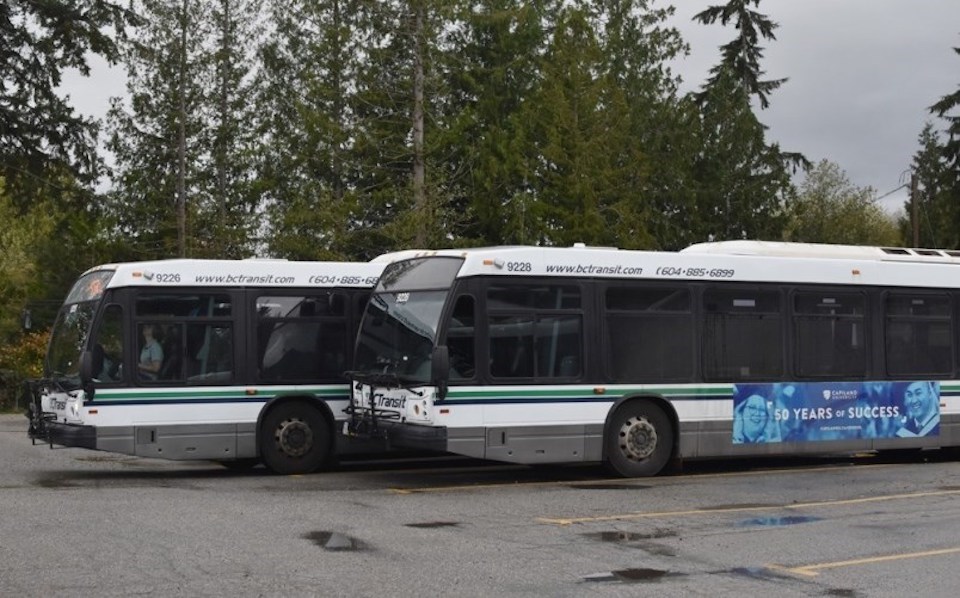How can the Coast upgrade its transit service to make it a more viable transportation choice? Make local bus travel free for youth under 18 and post-secondary school students. That proposal to build system ridership is being promoted by the Gibsons Transportation and Accessibility Committee (GTAC).
In a pitch delivered at the Jan. 26 Sunshine Coast Regional District’s (SCRD) committee of the whole meeting, GTAC representatives estimated the change would increase transit use by the area’s 1,250 secondary school students and about 150 young adults travelling for post-secondary studies on and off-Coast. They pointed out that local transit ridership has not recovered to pre-COVID levels and with the increases to the frequency of bus service on local Route 90, extra capacity is available to accommodate more students as bus passengers.
There was no SCRD committee recommendation made on the submission. The region’s elected officials encouraged the GTAC to continue to work with staff to develop the proposal further, with a view to potential implementation in 2024. At the meeting, community services manager Shelley Gagnon stated the project is in her department’s 2023 workplan.
“You had me at ‘Hello’,” Area F director Kate Louise Stamford stated in response to the presentation. “Moving forward we have to see transit use as the norm and have private car user-ship seen as the outliers.”
Area D director Kelly Backs said he viewed the proposal as “something that [the SCRD] could give to our community that would benefit everyone."
Economic, social and environmental 'wins'
GTAC spokespersons Colten Rockford, Cael Read and Anna Latanzi outlined how the proposal could be a “win” economically, socially and environmentally. While transit is free in BC for those under 12, the group stated extending that benefit to older students would reduce costs and social barriers for families and young adults, especially those with lower incomes.
According to Latanzi, a former Sunshine Coast Transit driver, that system has historically had limited service which created “a negative feedback loop where the lack of convenience led to low ridership.
“People are looking to transit to be more,” she said outlining that if the system could be viewed as convenient for local travel, families could opt to become one-vehicle rather than two-vehicle households, reducing their costs and environmental impacts. Making bus travel more affordable for youth and ingraining transit as a preferred transportation option early in life would help to “train the next generation to become transit users” she stated.
Rockford cited statistics related to the greenhouse gas (GHG) emission savings that increased transit use can create. Those included citing the SCRD’s GHG emissions inventory data that 32 per cent of emissions on the Coast are attributed to road transportation. Depending on occupancy levels, bus transportation creates between 30 and 80 per cent lower emissions per passenger than travel by single occupancy vehicle, according to the GTAC.
“We are in a climate emergency…we want to examine how we can change our on-road transportation and decrease our greenhouse gas emissions,” said Rockford.
The group also pointed to the benefit of reduced traffic congestion on local roads, noting that high levels of congestion are often seen near schools at student drop-off and pick-up times.
Backs agreed and pointed to time savings as another benefit of transit use by some students. He recounted that for his son, taking transit is more efficient than riding the school bus, reducing travel times by 45 minutes each way. “And when he asks me to drive him to school, it takes an hour out of my day and impacts my productivity as well as putting more greenhouse gasses into the atmosphere,” he said.
New fare card may be an opportunity
When it comes to making the new program work, the GTAC representatives stated that could be done through BC Transit’s soon to be introduced Umo fare card (similar to the lower mainland system’s Compass Card). Another option they suggested was having electronic fare chips integrated into school or post-secondary institution student ID cards.
With the Umo card introduction coming to Sunshine Coast Transit this spring, Rockford said an opportunity to gather data on youth use of the system, which currently does not exist, is being created. If data collection was done this year, he noted that could provide the SCRD with more accurate cost estimates of introducing the program in 2024. In his view, the suggested fare change will not have a large impact on transit revenues, as anecdotal evidence shows that bus use by youth and young adults is currently “low.”
Engaging students in Coast schools
The GTAC also proposed to promote increased use of the Coast’s buses by school-aged youth with a ramp up of a “Kids Ride the Bus” program to ensure they are familiar and comfortable with using the system. They recommended having local transit drivers visiting classrooms of grade 8 students to provide information and a “friendly face” to the system. Read stated that School District #46 “is on board” with the GTAC’s fare and student awareness proposals.
A similar proposal was brought to the SCRD in 2019 and the board approved having staff report back on the financial impacts of making the requested bus fare changes. Rockford noted that work to advance that e proposal “withered away with COVID’s impact.”



